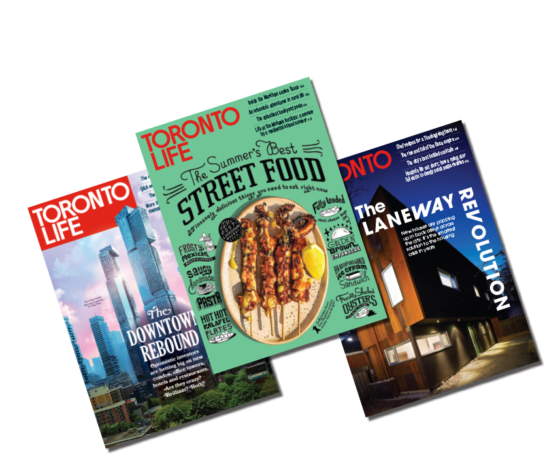“Toronto deserves a place on the world culinary map”: A Q&A with the head of the Michelin Guides on the city’s long-awaited restaurant list

Well, it finally happened: Toronto’s restaurants are being recognized by the most sought-after name in the dining game. The Michelin Guide announced on Monday that it would be releasing its first guide to the city’s restaurants, adding Toronto to a list of culinary capitals across the globe with guides of their own; it’s the first such guide in Canada, and only the sixth in North America. With Michelin inspectors already making their rounds, speculation has begun about which establishments will be included when the first edition of the guide is released this fall—or perhaps even receive an intensely coveted Michelin star or three.
Tasked with making sure Toronto’s restaurants get their due is Gwendal Poullennec, the international director of the Michelin Guides (pictured top left). We caught up with Poullennec after the big announcement at the Four Seasons Hotel to find out why Michelin decided now was the time to turn its eye to Toronto, how the pandemic affected the timing of the project, and if you’ll be able to spot a Michelin inspector if they’re seated next to you.
Putting on my ‘Toronto vs. Everybody’ hat for a moment here, can I ask what took so long for this day to arrive?
First of all, frankly, without the pandemic, the project we discussed today would have been revealed two years ago. We had to postpone because, of course, we did not want to compromise the quality of the selections and to give the industry enough time to recover, so that we can fairly recommend the best places to eat. Our inspectors have been in the area to monitor the evolution of the culinary landscape for more than four years now.
Other than doing everything possible to survive the pandemic, what about Toronto’s restaurants has been most impressive to the inspectors so far?
What is exciting about Toronto is not only what the culinary scene is today, but also its potential for growth in the coming years. So that’s really one of, if not, the main point for us before moving to our next destination. And referring to Canada, Toronto was an obvious first move because of the diversity, the vibrancy, the youthfulness of the local culinary scene. And let’s say that here also, you have a lot of gourmet. By that I mean that the local people are also the ones bringing up the quality of the food scene, because they are challenging the restaurants. And if I can add, our inspectors were really impressed by the fact that despite the pandemic, the chefs and their teams emerged even stronger than before.
But it’s still a precarious moment for many restaurants, after the past two years.
We took the decision to move to Toronto because we see a lot of potential also for the coming years. For me, what is exciting here is just the beginning. Today, we make the initial announcement that we start triggering the positive emulation within the industry that will hopefully help some restaurants to move to the next level before the first selection. And it is important to look at the impact we may have within the industry for the years to come. And definitely, the Michelin Guide also has a lot of ripple effects impacting the whole ecosystem in terms of job employment, of supply chain, of good local quality products. And that’s all the positive long-term effect that we can look at for the years to come.
You’ve overseen the launch of Michelin Guides around the world. When you think back to what first caught your eye about Toronto, are there any particular chefs or restaurants that stand out?
Unfortunately I can’t answer that, because I can’t get too specific at this time. And you would have to wait for the first reveal by the end of the year. What is important to mention again is, as we speak, it’s just the beginning and the selection is not yet over.
So how does the inspection process work—what is your team looking for?
Inspectors are in the field now, and they will remain there until the last minute before the first reveal to ensure that all ratings are up to date, so we can provide the most relevant and accurate recommendations. We do not have a quota or set numbers. So I don’t even know myself how many restaurants will be recommended within the first selection, because we will just pick up the restaurants according to the quality of the food they offer. And the famously anonymous inspectors, they always apply the same methodology with all five universal criteria: the quality of the products, mastery of the cooking technique, the harmony and balance of flavour, the personality of the chef and team that is expressed on the plate, and the consistency, both over time and throughout the menu as a whole. We utilize the same methodology everywhere to ensure that one star in Tokyo is worth one star in Paris, and eventually one star in Toronto.
About these inspectors, will I be able to spot them? Are there any tips for a restaurant to know there’s a Michelin inspector in the house?
I do know, but I can’t provide the answer because I can’t give them away. And the reason why? Because they have to remain purely anonymous.
Anonymity has always been key to the restaurant review process. But what kind of credentials does a Michelin inspector have?
Today, we have about 20 different nationalities of inspectors working for the Michelin Guide worldwide. They all travel the world to ensure they are familiar with all the different types of cuisine.
And that’s important because, for example, in Toronto, you have so many different cuisine types that you need to know about the Indian, Mexican, Japanese, French and many others. So that’s part of the reason why our inspectors travel the world.
And how much sway does an inspector have in who makes the guide? That’s an awful lot of responsibility, and power, to basically decide a restaurant’s fate.
Decisions are never a one-man show. We need several inspectors’ meals to align as a team on the recommendation and the decision. Basically, the same inspector is never going twice to the same place.
The Michelin Guide is renowned for recognizing the very best in fine dining, and there’s plenty of that here. But some of the best food I’ve eaten in Toronto has been in strip malls and food courts far outside the downtown core. Are your inspectors ready to be stuck in horrible Toronto traffic to evaluate these spots, too?
For the first selection, we will really focus on Toronto but our inspectors are really open-minded. Again, there’s no quota, no set numbers. Within the Michelin Guide, we are able to recognize all restaurants, whether they are street food, tapas bars or high-end luxury restaurants. And that’s really the way we work; we focus on the quality of the food and what is on the plate to highlight the most talented teams to the world.
Torontonians can be a fairly self-deprecating bunch, and we often look up to food cities like New York or Montreal as measuring posts. But we like external validation. What can you tell us about our food scene to really pump our tires?
Oh, many things—and no doubt that we will have many more to add when we will do the first release. Our inspectors definitely have been impressed—both before and after Covid, by the resilience of the industry—but also by the diversity, by the vibe, the dynamism, the different concepts, all the young chefs. There are some international chefs, but many of them are homegrown, so there’s no doubt that Toronto would be able to add its unique flavours to the world culinary stage. Toronto deserves a place on the world culinary map.






